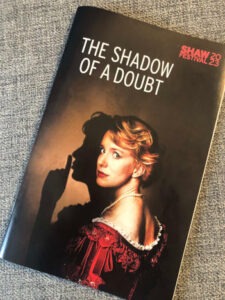
The Shadow Of A Doubt At The Shaw Festival
The Shaw Festival has a history of rediscovering long-forgotten plays. With The Shadow Of A Doubt they’ve done themselves one better by producing the world premiere of a 1901 play by none other than Edith Wharton, the first woman to receive a Pulitzer, not in drama but for her 1920 novel “The Age of Innocence.”
The story of how The Shadow Of A Doubt was discovered only recently, misplaced in the library at the University of Texas, need not concern us here. More to the point, is it any good?
The doubt in The Shadow Of A Doubt swirls around Kate Derwent (Katherine Gauthier), confidant and nurse to the late Agnes Derwent. Kate attended her in her final, pain-wracked days after a riding accident. Kate is now married to John Derwent (André Morin), Agnes’ husband. As the play opens they have returned from a year’s tour of the Continent with Sylvia (Chloe Bowman and Julia Thompson alternating) Agnes’ tween daughter.
Lord Osterleigh (Patrick Galligan), Agnes’ father, is none too happy that John has remarried a woman of the lower orders (so he considers Kate). He shares his concerns with Lady Uske (Tara Rosling) an old friend and confidante who seems open to rekindling an old flame. It disturbs him deeply that Sylvia now calls Kate “mummy” and that Kate, hardly an appropriate role model, will be bringing up his granddaughter.
The plot of The Shadow Of A Doubt really gets rolling with the arrival, through a window, of Dr. Carruthers (Damien Atkins). He was the attending physician during Agnes’ final days, and now finds himself in drastically reduced circumstances. He has come to blackmail Kate, accusing her of euthanasia, illegal then as it remains today in many jurisdictions.
Intriguingly, when Carruthers levels his accusations in the presence of John, Kate acknowledges the bare facts – yes, she provided chloroform – but denies being a murderess. John stands by her version of events.
In Act Two we learn that John is being sent on an important mission to China and must leave immediately. It becomes obvious that the assignment, which will supposedly situate John for great things in the future, was orchestrated by Lord Osterleigh.
Osterleigh wants Sylvia to stay with him, not Kate, during John’s absence. Kate, as befits a proper Edwardian wife, defers to John, who seems to have a spine the consistency of a wet noodle. He agrees that Lord Osterleigh’s wishes should prevail. Kate responds by leaving her husband’s house and moving, anonymously, to a cheap rooming house.
In Act Three, months later, in an increasingly melodramatic series of confrontations, Kate reveals the real reason the shadow of a doubt hangs over her. And it has nothing to do with euthanasia.
Much can be made of The Shadow Of A Doubt’s debt to Ibsen (Kate leaves home, after all) and Wharton gives Lady Uske some nice Wildean flashes of wit. When Lord Osterleigh says that Kate’s early life was a constant struggle with poverty, Lady Uske sighs that hers has been a constant struggle with wealth.
What light, if any, The Shadow Of A Doubt casts on Wharton’s subsequent literary output I will leave to the Wharton scholars. But the question remains: How does the material hold up for a modern audience?
That’s hard to say because Peter Hinton-Davis, the Darren Nichols of Shaw’s directorial stable, has burdened the production with a seemingly never-ending succession of tics, conceits, pregnant pauses, and meta-theatrical devices. They are confusing, tedious, distracting, and inexplicable in approximately equal measure. They do nothing to illuminate the text and a great deal to obscure it.
Designer Gillian Gallow, presumably at the director’s request, has provided a massive black set. It’s as if Louise Nevelson had decided to become an Edwardian architectural woodworker. Her costumes largely adhere to the same black palette, although in Act Two Kate is resplendent in white. A symbol? If so, of what?
The most annoying directorial improvement to The Shadow Of A Doubt is the extensive use of video. Cameras strategically positioned in the wings and around the stage itself capture characters’ faces and project them against the back walls of Gallow’s oppressive black sets. During the climactic confrontation in Act Three, Lord Osterleigh is required to turn his back on Kate to deliver his lines directly into a downstage-right mini camera, his larger than life visage projected on the wall.
Despite all the distractions, many of the actors manage to shine and Hinton-Davis must be given due credit for their success. Patrick Galligan is quite brilliant as Lord Osterleigh and he makes his last-minute epiphany work beautifully. Damien Atkins does wonders with the pitiful Dr. Carruthers in one of the few scenes in which Hinton-Davis’s tendency to overdo actually works.
Tara Rosling is by turns droll and elegantly bewitching as Lady Uske, while Neil Barclay scores in the small role of her fatuous husband.
Katherine Gauthier, whom I admired in last season’s Just To Get Married, is a bit of a cypher as Kate. That may be because the director was too busy elsewhere to guide her through her character’s arc.
I have a suspicion that if all the directorial “improvements” were scraped away and the script placed in the hands of a director who would move the action along briskly, The Shadow Of A Doubt would emerge as a rather dated but still watchable soap opera cum melodrama.
Despite all my misgivings about the production, the play held my interest, my companion’s less so. As always, your mileage may differ.
The Shadow Of A Doubt continues at the Shaw Festival’s Royal George Theatre through October 15, 2023. For more information and to purchase tickets visit the Shaw Festival website.
More Reviews
To access the complete archive of reviews listed alphabetically CLICK HERE.

